Theotokos
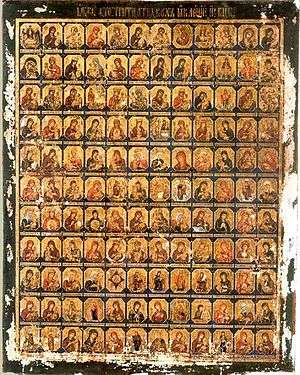
Theotokos (Greek Θεοτόκος Greek pronunciation: [θeoˈtokos][1]) is a title of Mary, mother of Jesus, used especially in Eastern Christianity. The usual Latin translations, Dei Genetrix or Deipara (approximately "parent (fem.) of God", are translated as "Mother of God" or "God-bearer".[2]
The Council of Ephesus decreed in 431 that Mary is the Theotokos because her son Jesus is both God and man: one divine person with two natures (divine and human) intimately and hypostatically united.[3][4] Theotokos is also used as the term for an Eastern icon, or type of icon, of the Mother with Child (in the western tradition typically called a Madonna, as in "the Theotokos of Vladimir" both for the original 12th-century icon and for icons that are copies or imitate its composition.
Similar to this is the title of Mother of God (Greek Μήτηρ (του) Θεοῦ; abbreviated ΜΡ ΘΥ, Latin Mater Dei). "Mother of God" (and equivalents) is most often used in English (and other modern western languages), largely due to the lack of a satisfactory equivalent of Greek τόκος / Latin genetrix.
The title has been in use since the 3rd century, in the Syriac tradition (as Syriac: ܝܳܠܕܰܬ ܐܰܠܳܗܳܐ, translit. Yoldath Alloho) in the Liturgy of Mari and Addai (3rd century)[5] and the Liturgy of St James (4th century).[6]
Terminology
Theotokos is an adjectival compound of two the Greek words Θεός "God" and τόκος "childbirth, parturition; offspring". A close paraphrase would be "[she] whose offspring is God" or "[she] who gave birth to one who was God".[7] The usual English translation is simply "Mother of God"; Latin uses Deipara or Dei Genetrix. The Church Slavonic translation is Bogoroditsa (Russian/Macedonian/Bulgarian Богородица). The full title of Mary in Slavic Orthodox tradition is Прест҃а́ѧ влⷣчица на́ша бцⷣа и҆ прⷭ҇нод҃ва мр҃і́а (Russian Пресвятая Владычица наша Богородица и Приснодева Мария), from Greek Ὑπεραγία δεσποινίς ἡμῶν Θεοτόκος καὶ ἀειπαρθένος Μαρία "Our Most Holy Lady Theotokos and Ever-Virgin Mary". German has the translation Gottesgebärerin.
"Mother of God" is the literal translation of a distinct title in Greek, Μήτηρ του Θεού (translit. Mētēr tou Theou), a term which has an established usage of its own in traditional Orthodox and Catholic theological writing, hymnography, and iconography.[8] In an abbreviated form, ΜΡ ΘΥ (М҃Р Ѳ҃Ѵ), it often is found on Eastern icons, where it is used to identify Mary. The Russian term is Матерь Божия (also Богома́терь).[9]
Variant forms are the compounds Θεομήτωρ (translit. Theomētor; also spelled Θεομήτηρ, translit. Theomētēr) and Μητρόθεος (translit. Mētrotheos), which are found in patristic and liturgical texts.[10][11]
The theological dispute over the term concerned the term Θεός "God" vs. Χριστός "Christ", and not τόκος (genetrix, "bearer") vs. μήτηρ (mater, "mother"), and the two terms have been used as synonyms throughout Christian tradition. Both terms are known to have existed alongside one another since the early church, but it has been argued, even in modern times, that the term "Mother of God" is unduly suggestive of Godhead having its origin in Mary, imparting to Mary the role of a Mother Goddess. But this is an exact reiteration of the objection by Nestorius, resolved in the 5th century, to the effect that the term "Mother" expresses exactly the relation of Mary to the incarnate Son ascribed to Mary in Christian theology. [12]
Theology
| A series of articles on |
| Mariology |
|---|
 |
| General perspective |
| Specific views |
|
|
| Prayers and devotions |
| Ecumenical |
|
|
Theologically, the term "Mother of God" (and its variants) should not be taken to imply that Mary is the source of the existence of the divine person of Jesus, who existed with the Father from all eternity,[13] or of her Son's divinity.[14] Within the Orthodox and Catholic tradition, Mother of God has not been understood, nor been intended to be understood, as referring to Mary as Mother of God from eternity — that is, as Mother of God the Father — but only with reference to the birth of Jesus, that is, the Incarnation. To make it explicit, it is sometimes translated Mother of God Incarnate.[15] (c.f. the topic of Christology, and the titles of God the Son and Son of man).
The status of Mary as Theotokos was a topic of theological dispute in the 4th and 5th centuries, and was the subject of the decree of the Council of Ephesus of 431, to the effect that, in opposition to those who denied Mary the title Theotokos ("the one who gives birth to God") but called her Christotokos ("the one who gives birth to Christ"), that Mary is Theotokos because her son Jesus is one person who is both God and man, divine and human.[3][4] This decree created the Nestorian Schism. Cyril of Alexandria wrote, "I am amazed that there are some who are entirely in doubt as to whether the holy Virgin should be called Theotokos or not. For if our Lord Jesus Christ is God, how is the holy Virgin who gave [Him] birth, not [Theotokos]?" (Epistle 1, to the monks of Egypt; PG 77:13B). But the argument of Nestorius was that divine and human natures of Christ were distinct, and while Mary is evidently the Christotokos (bearer of Christ), it could be misleading to describe her as the "bearer of God". At issue is the interpretation of the Incarnation, and the nature of the hypostatic union of Christ's human and divine natures between Christ's conception and birth.
Within the Orthodox doctrinal teaching on the economy of salvation, Mary's identity, role, and status as Theotokos is acknowledged as indispensable. For this reason, it is formally defined as official dogma. The only other Mariological teaching so defined is that of her virginity. Both of these teachings have a bearing on the identity of Jesus Christ. By contrast, certain other Marian beliefs which do not bear directly on the doctrine concerning the person of Jesus (for example, her sinlessness, the circumstances surrounding her conception and birth, her Presentation in the Temple, her continuing virginity following the birth of Jesus, and her death), which are taught and believed by the Orthodox Church (being expressed in the Church's liturgy and patristic writings), are not formally defined by the Church.
History of use
Early Church
The term was certainly in use by the 3rd century. Athanasius of Alexandria in 330, Gregory the Theologian in 370, John Chrysostom in 400, and Augustine all used theotokos.[16]
Origen (d. 254) is often cited as the earliest author to use theotokos for Mary (Socrates, Ecclesiastical History 7.32 (PG 67, 812 B) citing Origen's Commentary on Romans). Although this testimony is uncertain, the term was used c. 250 by Dionysius of Alexandria, in an epistle to Paul of Samosata.[17]
The Greek version of the hymn Sub tuum praesidium contains the term, in the vocative, as ΘΕΟΤΟΚΕ. The oldest record of this hymn is a papyrus found in Egypt, mostly dated to after 450 .[18] but according to a suggestion by de Villiers (2011) possibly older, dating to the mid-3rd century.[17]
Third Ecumenical Council
| A series of articles on |
| Mother of Jesus |
| Chronology |
|---|
|
|
| Marian perspectives |
|
|
| Catholic Mariology |
|
|
| Marian dogmas |
|
|
| Mary in culture |
|
|
The use of Theotokos was formally affirmed at the Third Ecumenical Council held at Ephesus in 431. The competing view, advocated by Patriarch Nestorius of Constantinople, was that Mary should be called Christotokos, meaning "Birth-giver of Christ," to restrict her role to the mother of Christ's humanity only and not his divine nature.
Nestorius' opponents, led by Cyril of Alexandria, viewed this as dividing Jesus into two distinct persons, the human who was Son of Mary, and the divine who was not. To them, this was unacceptable since by destroying the perfect union of the divine and human natures in Christ, it sabotaged the fullness of the Incarnation and, by extension, the salvation of humanity. The council accepted Cyril's reasoning, affirmed the title Theotokos for Mary, and anathematized Nestorius' view as heresy. (See Nestorianism)
In letters to Nestorius which were afterwards included among the council documents, Cyril explained his doctrine. He noted that "the holy fathers... have ventured to call the holy Virgin Theotokos, not as though the nature of the Word or his divinity received the beginning of their existence from the holy Virgin, but because from her was born his holy body, rationally endowed with a soul, with which [body] the Word was united according to the hypostasis, and is said to have been begotten according to the flesh" (Cyril's second letter to Nestorius).
Explaining his rejection of Nestorius' preferred title for Mary (Christotokos), Cyril wrote:
"Confessing the Word to be united with the flesh according to the hypostasis, we worship one Son and Lord, Jesus Christ. We do not divide him into parts and separate man and God as though they were united with each other [only] through a unity of dignity and authority... nor do we name separately Christ the Word from God, and in similar fashion, separately, another Christ from the woman, but we know only one Christ, the Word from God the Father with his own flesh... But we do not say that the Word from God dwelt as in an ordinary human born of the holy virgin... we understand that, when he became flesh, not in the same way as he is said to dwell among the saints do we distinguish the manner of the indwelling; but he was united by nature and not turned into flesh... There is, then, one Christ and Son and Lord, not with the sort of conjunction that a human being might have with God as in a unity of dignity or authority; for equality of honor does not unite natures. For Peter and John were equal to each other in honor, both of them being apostles and holy disciples, but the two were not one. Nor do we understand the manner of conjunction to be one of juxtaposition, for this is insufficient in regard to natural union.... Rather we reject the term 'conjunction' as being inadequate to express the union... [T]he holy virgin gave birth in the flesh to God united with the flesh according to hypostasis, for that reason we call her Theotokos... If anyone does not confess that Emmanuel is, in truth, God, and therefore that the holy virgin is Theotokos (for she bore in a fleshly manner the Word from God become flesh), let him be anathema." (Cyril's third letter to Nestorius)
Nestorian Schism
The Syrian Church the Nestorian Church, known as the Church of the East within the Syrian tradition, rejected the decision of the Council of Ephesus and its confirmation at the Council of Chalcedon in 451. This was the church of the Sassanid Empire during the late 5th and early 6th centuries. The schism ended in 544, when patriarch Aba I ratified the decision of Chalcedon. After this, there was no longer technically any "Nestorian Church", i.e. a church following the doctrine of Nestorianism, although legends persisted that still further to the east such a church was still in existence (associated in particular with the figure of Prester John), and the label of "Nestorian" continued to be applied even though it was technically no longer correct. Modern research suggests that also the Church of the East in China did not teach a doctrine of two distinct natures of Christ."[19]
Reformation
Lutheran tradition retained the title of "Mother of God" (German Mutter Gottes, Gottesmutter), a term already embraced by Martin Luther;[20] and officially confessed in the Formula of Concord (1577),[21] accepted by Lutheran World Federation.[22]
Liturgy
Theotokos is often used in hymns to Mary in the Eastern Orthodox, Eastern Catholic and Oriental Orthodox churches. The most common is Axion Estin (It is truly meet), which is used in nearly every service.
Other examples include Sub tuum praesidium, the Hail Mary in its Eastern form, and All creation rejoices, which replaces Axion Estin at the Divine Liturgy on the Sundays of Great Lent. Bogurodzica is a medieval Polish hymn, possibly composed by Adalbert of Prague (d. 997).
The Solemnity of Mary, Mother of God is a Roman Catholic feast day introduced in 1969, based on older traditions associating 1 January with the motherhood of Mary.[23]
Iconography
One of the two earliest known depictions of the Virgin Mary is found in the Catacomb of Priscilla (3rd century) showing the adoration of the Magi. Recent conservation work at the Catacombs of Priscilla revealed that what had been identified for decades as the earliest image of the Virgin and Child was actually a traditional funerary image of a Roman matron; the pointing figure with her, formerly identified as a prophet, was shown to have had its arm position adjusted and the star he was supposedly pointing to was painted in at a later date.[24] The putative Annunciation scene at Priscilla is also now recognized as yet another Roman matron with accompanying figure and not the Virgin Mary. Recently another third-century image of the Virgin Mary was identified at the eastern Syrian site of Dura Europos in the baptistry room of the earliest known Christian Church. The scene shows the Annunciation to the Virgin.[25]
The tradition of Marian veneration was greatly expanded only with the affirmation of her status as Theotokos in 431. The mosaics in Santa Maria Maggiore in Rome, dating from 432-40, just after the council, does not yet show her with a halo. The iconographic tradition of the Theotokos or Madonna (Our Lady), showing the Virgin entrhoned carrying the infant Christ, is established by the following century, as attested by a very small number of surviving icons, including one at Saint Catherine's Monastery in Sinai, and Salus Populi Romani, a 5th or 6th-century Byzantine icon preserved in Rome. This type of depiction, with subtly changing differences of emphasis, has remained the mainstay of depictions of Mary to the present day. The roughly half-dozen varied icons of the Virgin and Child in Rome from the 6th to 8th centuries form the majority of the representations surviving from this period, as most early Byzantine icons were destroyed in the Byzantine Iconoclasm of the 8th and 9th century,[26] notable exceptions being the 7th-century Blachernitissa and Agiosoritissa.
The iconographic tradition is well developed by the early medieval period. The tradition of Luke the Evangelist being the to have painted Mary is established by the 8th century.[27] An early icon of the Virgin as queen is in the church of Santa Maria in Trastevere in Rome, datable to 705-707 by the kneeling figure of Pope John VII, a notable promoter of the cult of the Virgin, to whom the infant Christ reaches his hand. The earliest surviving image in a Western illuminated manuscript of the Madonna and Child comes from the Book of Kells of about 800 (there is a similar carved image on the lid of St Cuthbert's coffin of 698). The oldest Russian icons were imports from Byzantium, beginning in the 11th century.
 Salus Populi Romani, Rome (5th or 6th century)
Salus Populi Romani, Rome (5th or 6th century) Theotokos icon of Saint Catherine's Monastery, Sinai (6th century)
Theotokos icon of Saint Catherine's Monastery, Sinai (6th century)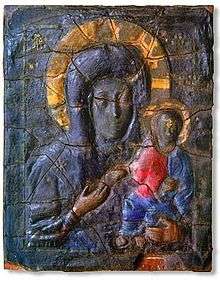 Blachernae Icon of the Theotokos (7th century)
Blachernae Icon of the Theotokos (7th century) Mother of God, mosaic icon, Hagia Sophia (12th century)
Mother of God, mosaic icon, Hagia Sophia (12th century)
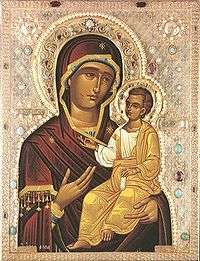 The Iveron Theotokos (Iverskaya), an 11th-century Russian icon based on the 10th-century Hodegetria type, Iviron Monastery, Mount Athos.
The Iveron Theotokos (Iverskaya), an 11th-century Russian icon based on the 10th-century Hodegetria type, Iviron Monastery, Mount Athos. Theotokos Panachranta from Svensky Monastery, by St. Alypios of Kiev (11th century)
Theotokos Panachranta from Svensky Monastery, by St. Alypios of Kiev (11th century)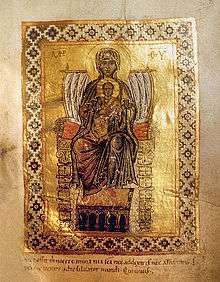 Panachranta Theotokos, mid-11th-century Kievan illumination from the Gertrude Psalter.
Panachranta Theotokos, mid-11th-century Kievan illumination from the Gertrude Psalter.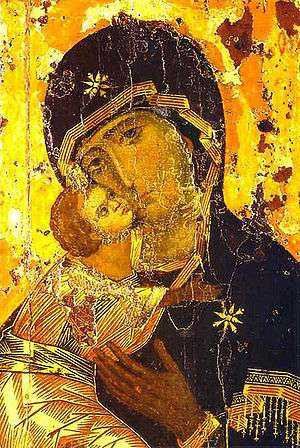 Theotokos of Vladimir (c. 1100)
Theotokos of Vladimir (c. 1100) Theotokos of St. Theodore (12th century)
Theotokos of St. Theodore (12th century) Our Lady Derzhavnaya (18th century)
Our Lady Derzhavnaya (18th century) Bogomater of the "Unfading Flower" (Неувядаемый Цвет) type (18th century, Tretyakov Gallery)
Bogomater of the "Unfading Flower" (Неувядаемый Цвет) type (18th century, Tretyakov Gallery)
See also
References
- ↑ English pronunciation: /ˌθiːəˈtoʊkoʊs, ˌθeɪə-, -ˈtɒ-, -kəs/; "Theotokos". Merriam-Webster Dictionary. "Theotokos". Dictionary.com Unabridged. Random House.
- ↑ Ph. Schaff, H Wace Nicene and Ante-Nicene Fathers, II.XIV ("Excursus on the Word Θεοτόκος") object to "God-bearer" being characterised as "exact translation", as the literal equivalent of "God-bearer" is Θεοφόρος, not Θεοτόκος. Greek Θεοτόκος is a feminine adjectival compound translating "she whose offspring is God". J.F. Bethune-Baker, Nestorius and His Teachings: A Fresh Examination of the Evidence (1998), p. 58 ( "who gave birth to one who was God", "whose child was God").
- 1 2 Mary, Mother of God by Carl E. Braaten and Robert W. Jenson 2004 ISBN 0802822665 page 84
- 1 2 "NPNF2-14. The Seven Ecumenical Councils - Christian Classics Ethereal Library". Ccel.org. 2005-06-01. Retrieved 2012-10-04.
- ↑ Addai and Mari, Liturgy of. Cross, F. L., ed. The Oxford Dictionary of the Christian Church. Oxford University Press. 2005. "Book for people in English". Kaldu.org. Retrieved 2013-11-03.
- ↑ John Witvliet, "The Anaphora of St. James" in ed. F. Bradshaw Essays on Early Eastern Eucharistic Prayers, 1997. "CHURCH FATHERS: Divine Liturgy of St. James". Newadvent.org. Retrieved 2013-11-03.
- ↑ J.F. Bethune-Baker, Nestorius and His Teachings: A Fresh Examination of the Evidence (1998), p. 58 ( "who gave birth to one who was God", "whose child was God"). Pelikan, Jaroslav (1998). Mary Through the Centuries. Yale University Press. p. 55. ISBN 978-0-300-07661-5.
- ↑ The Second Vatican Council stated: "Clearly from earliest times the Blessed Virgin is honoured under the title of Mother of God." Pope Paul VI, Lumen gentium, 66
- ↑ Богоматерь-Богородица Энциклопедический словарь Брокгауза и Ефрона : в 86 т. (82 т. и 4 доп.). — СПб., 1890—1907.
- ↑ On Martyrs: Speech on Simeon, Anne, at the day of the Presentation, and the Holy Theotokos. Saint Methodius of Patara (1865). Albert Jahnius, ed. S. Methodii Opera Et S. Methodius Platonizans (in Greek and Latin). Pars I. Halis Saxonum, C.E.M. Pfeffer. pp. 109, 110. (... [80] περιφανῶς ἡ ἱερὰ θεομήτωρ ἐξετέλει ... [109] ἐκφαντικώτατά σε τὴν θεοτόκον προσημαίνουσαν ...)
- ↑ Dionysios Pyrros (1852). Panthektē: hiera ekklēsiastikē periechousa to Pentēkostarion (in Greek). 2. p. 904. (... πῶς δῆ ἡ μητρόθεος ...)
- ↑ "Pearson is mistaken in supposing that the resolution of the compound Theotocos into μήτηρ τοῦ Θεοῦ was unknown to the early Greek writers. [...] It is not an open question whether Mater Dei, Dei Genetrix, Deipara, μήτηρ τοῦ Θεοῦ are proper equivalents for Θεοτόκος. This point has been settled by the unvarying use of the whole Church of God throughout all the ages from that day to this, but there is, or at least some persons have thought that there was, some question as to how Theotocos should be translated into English. Throughout this volume I have translated it 'Mother of God,' and I propose giving my reasons for considering this the only accurate translation of the word, both from a lexico-graphical and from a theological point of view. (a) It is evident that the word is a composite formed of Θεός = God, and τίκτειν = to be the mother of a child. Now I have translated the verbal part 'to be the mother of a child' because 'to bear' in English does not necessarily carry the full meaning of the Greek word, which (as Bp. Pearson has well remarked in the passage cited above) includes 'conception, nutrition, and parturition.' It has been suggested that 'God-bearer' is an exact translation. To this I object, that in the first place it is not English; and in the second that it would be an equally and, to my mind, more accurate translation of Θεοφόρος than of Θεοτόκος. Another suggestion is that it be rendered 'the bringer forth of God.' Again I object that, from a rhetorical standpoint, the expression is very open to criticism; and from a lexicographical point of view it is entirely inadequate, for while indeed the parturition does necessarily involve in the course of nature the previous conception and nutrition, it certainly does not express it. Now the word Mother does necessarily express all three of these when used in relation to her child. The reader will remember that the question I am discussing is not whether Mary can properly be called the Mother of God; this Nestorius denied and many in ancient and modern times have been found to agree with him. [...] (b) It only remains to consider whether there is from a theological point of view any objection to the translation, 'Mother of God.' It is true that some persons have thought that such a rendering implied that the Godhead has its origin in Mary, but this was the very objection which Nestorius and his followers urged against the word Theotocos, and this being the case, it constitutes a strong argument in favour of the accuracy of the rendering. Of course the answer to the objection in each case is the same, it is not of the Godhead that Mary is the Mother, but of the Incarnate Son, who is God. 'Mother' expresses exactly the relation to the incarnate Son which St. Cyril, the Council of Ephesus, and all succeeding, not to say also preceding, ages of Catholics, rightly or wrongly, ascribe to Mary. [...]" Ph. Schaff, H Wace (eds.), Early Church Fathers, Nicene and Ante-Nicene Fathers, Ser. II, Vol. XIV, "Excursus on the Word Θεοτόκος"
- ↑ Father William Saunders (December 22, 1994), Mary, Mother of God, The Arlington Catholic Herald (retrieved from EWTN)
- ↑ Mary: Mother of God, Nihil obstat by Bernadeane Carr, STL; Imprimatur by Robert H. Brom, Bishop of San Diego, Catholic Answers, August 10, 2004
- ↑ "We recognize the Blessed Virgin Mary as the Theotókos, the mother of God incarnate, and so observe her festivals and accord her honour among the saints." Mary: Grace and Hope in Christ by the Anglican-Roman Catholic International Commission (ARCIC II)
- ↑ "The rejection of the term Theotokos by Nestorius Constantinople and the refutation of his teaching by Cyril of Alexandria". Egolpion.com. 2012-06-24. Retrieved 2012-10-04.
- 1 2 de Villiers, Henri (2011-02-03). "The Sub Tuum Praesidium". New Liturgical Movement. Retrieved 2012-10-04..
- ↑ G. Vannucci, Marianum, 1941 (3), pp. 97-101, "La piu antica preghiera alla Madre de Dio". P. Ryl. Gr. 3 470 (Roberts, Colin Henderson) = Le Muséon 52 (1939), p. 229-233 (Mercenier, P. F. ) = Zeitschrift für Katholische Theologie 74 (1952), p. 76-82 (Stegmüller, Otto). "Date: AD 450 - 799".
- ↑ Hofrichter, Peter L. (2006). "Preface". In Malek, Roman; Hofrichter, Peter (editors). Jingjiao: the Church of the East in China and Central Asia. Steyler Verlagsbuchhandlung GmbH. ISBN 978-3-8050-0534-0.
- ↑ Basely, Joel R. (2005). Festival Sermons of Martin Luther. Dearborn, Michigan: Mark V Publiscations. p. 167. ISBN 0-9652403-1-2.
- ↑ Theodore G. Tappert, "Solid Declaration, article VIII.24", The Book of Concord: The Confessions of the Evangelical Lutheran Church (1959 ed.), Philadelphia: Fortress Press, p. 595
- ↑ "The Ecumenical Councils and Authority in and of the Church", 7th Plenary in Sandbjerg, Denmark (PDF), The Lutheran World Federation, 10 July 1993
- ↑ The 1969 revision of the liturgical year and the calendar states: "1 January, the Octave Day of the Nativity of the Lord, is the Solemnity of Mary, the Holy Mother of God, and also the commemoration of the conferral of the Most Holy Name of Jesus." Universal Norms on the Liturgical Year and the Calendar, 35 f. In his Apostolic Letter, Marialis Cultus, Pope Paul VI explained: "This celebration, placed on January 1 ...is meant to commemorate the part played by Mary in this mystery of salvation. It is meant also to exalt the singular dignity which this mystery brings to the 'holy Mother...through whom we were found worthy to receive the Author of life.'" Pope Paul VI, Marialis Cultus, §5, February 2, 1974, Vatican
- ↑ Geri Parlby, “The Origins of Marian Art in the Catacombs and the Problems of Identification,” in Chris Maunder, ed., Origins of the Cult of the Virgin Mary (London: Bloomsbury Academic, 2008) 41-56.
- ↑ Michael Peppard, The World’s Oldest Church: Bible, Art and Ritual at Dura Europos, Syria (New Haven: Yale, 2015)
- ↑ Nees, Lawrence. Early medieval art, 143-145, quote 144, Oxford University Press, 2002, ISBN 0-19-284243-9, ISBN 978-0-19-284243-5
- ↑ Michele Bacci, Il pennello dell'Evangelista. Storia delle immagini sacre attribuite a san Luca (Pisa: Gisem, 1998).
Recommended reading
- Maunder, Chris (ed.), The Origins of the Cult of the Virgin Mary , (2008, burns & oates/continuumbooks). ISBN 978-0-86012-456-6
- Artemi, Eirini, « The mystery of the incarnation into dialogues "de incarnatione Unigenitii" and "Quod unus sit Christus" of St. Cyril of Alexandria », Ecclesiastic Faros of Alexandria, ΟΕ (2004), 145-277.
- Cyril of Alexandria, On the Unity of Christ, John Anthony McGuckin, trans. ISBN 0-88141-133-7
- McGuckin, John Anthony, St. Cyril of Alexandria: The Christological Controversy (1994, and reprinted 2004) ISBN 0-88141-259-7 A full description of the events of Third Ecumenical Council and the people and issues involved.
- Saint John of Shanghai and San Francisco,""The Orthodox Veneration of Mary, The Birth Giver of God"(2004, Sixth Printing, Third Edition). ISBN 0-938635-68-9
- Ware, Bishop Kallistos, "The Orthodox Way" (1979, Revised Edition, 1995, and reprinted 1999). ISBN 0-913836-58-3
External links
| Look up Mother of God in Wiktionary, the free dictionary. |
| Wikimedia Commons has media related to Theotokos. |
- Theotokos article on the Orthodox Wiki
- Resources on the Theotokos
- Study of the Mother of the Lord the All-Holly Theotokos and Ever-Virgin Mary by St. Nectarios (in Greek)
- The rejection of the term Theotokos by Nestorius Constantinople and the refutation of his teaching by Cyril of Alexandria, Eirini Artemi, Oxford, August 2011
- The rejection of the term Theotokos by Nestorius Constantinople by Eirini Artemi

